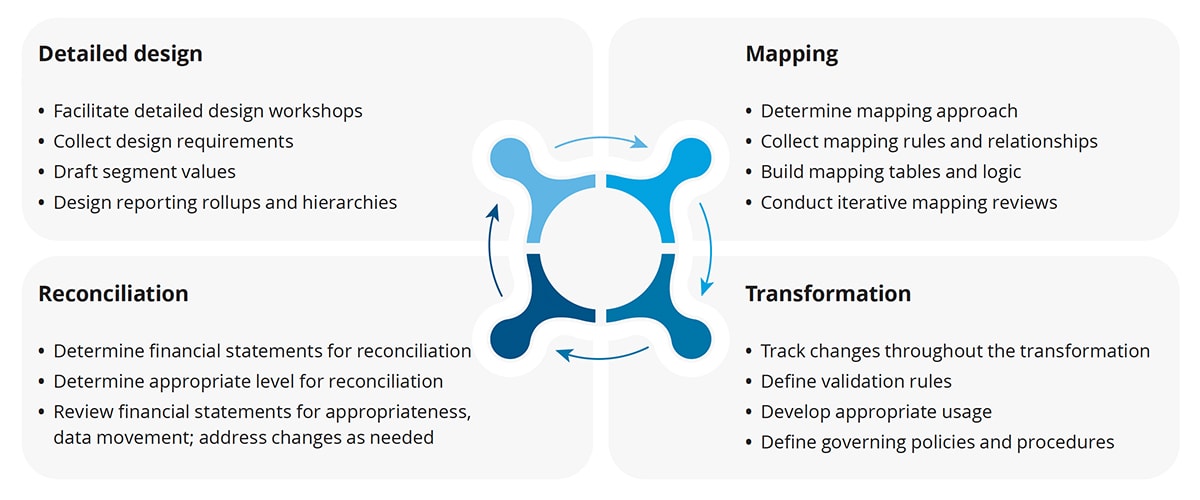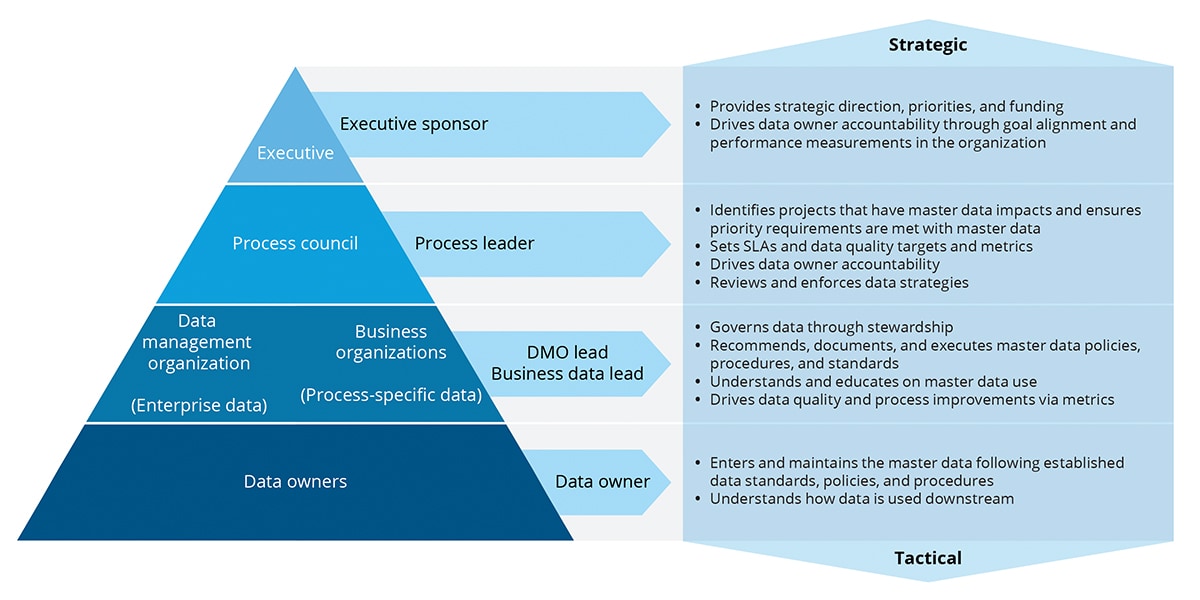Establishing a “built to evolve” finance data strategy has been saved

Perspectives
Establishing a “built to evolve” finance data strategy
Robust enterprise information and data governance models
Overhauling enterprise information models is a common component of finance transformations, especially when enterprise resource planning (ERP) systems are involved. Defining a finance data strategy that emphasizes adaptability, along with an effective data governance model, can help companies keep up with new business and regulatory requirements.
Explore content
- Defining the finance data strategy, enterprise information model, and data governance model
- Establishing a finance data strategy
- Building an enterprise information model
- Establishing a data governance model
- Specific considerations
Defining the finance data strategy, enterprise information model, and data governance model
Imagine you just learned that your business is about to undergo a management reorganization that will require fundamental changes to your enterprise resource planning (ERP) design. Now you need the new structure to be ready within two months to support the upcoming budget cycle. As you digest the task ahead, you quickly realize that the ERP system launched just last year was hardwired to support a reporting structure that is now obsolete.
To make matters worse, the lack of a finance data governance model has resulted in thousands of cost centers with inconsistent definitions, making it nearly impossible to map historical financials to a new organizational structure. Unfortunately, your company did not design an enterprise information model that was built to evolve over time, and the lack of governance has led to “dirty” master data infiltrating your new ERP. How will you break the news to your stakeholders that, despite significant investment in modernizing your ERP, it is not capable of adapting to changing business requirements?
While undergoing any finance transformation, especially investments in an ERP, it will likely be necessary to rearchitect your finance data model. However, the ever-increasing velocity of change in today’s global economy presents significant challenges when designing a data model that will be relevant 10 or even five years from now.
Instead of creating a data model that is “built to last,” it is better to create a data model that is “built to evolve.” This requires investing time up front to define a finance data strategy that includes an enterprise information model that meets today’s needs and can adapt to future change. It is also essential to implement a data governance model that enables you to track whether your finance data remains clean and consistent well after the project is complete.
Establishing a finance data strategy
The finance data strategy defines how the organization will leverage data to achieve the desired outcomes of finance transformation while accommodating the unique challenges and constraints of your existing business environment. The development of a finance data strategy at the beginning of a project brings awareness to the importance of data and provides a foundation to begin making design decisions. The data strategy provides a framework to document how the organization intends to address key design decisions, who needs to be included, and what principles will guide the decision-making process.
It’s important to note that the finance data strategy should not be considered set in stone after completing initial development sessions. As the finance transformation kicks off, education and design workshops will uncover new learnings and requirements that need continual refinement and course adjustment. A meaningful finance data strategy will serve as a guiding star throughout the transformation, helping workstreams stay on track, getting new team members up to speed, and serving as a tool to help resolve gridlocked discussions.
“Big rock” topics to consider around finance data strategy
Click image to enlarge
Building an enterprise information model
The enterprise information model provides the foundation on which an organization’s business processes and reporting will be built. It transforms a generic ERP package into a specific structure to fit the needs of your organization. The ideal enterprise information model should be robust, purposefully built, and tailored to the organization’s business model while still allowing flexibility for new product launches, reorganizations, or acquisitions. A complex, layered, and well-defined enterprise information model should provide the business with flexible reporting, harmonized transaction processing, business model agility, and expanded views of transactions and profitability.
Developing a flexible, multidimensional finance data model requires high-quality inputs from all applicable stakeholder groups. These inputs are obtained by conducting multiple design cycles to align with business process requirements, rationalize master data values, visualize design decisions, and assess impact on internal and external reporting. This iterative approach transforms the data model design with each cycle, becoming more complex and closer to business reality while being validated by the different stakeholder groups throughout the organization.
Each iteration of design should be integrated with real-time reconciliation, mapping, and transformation rules for stakeholders to understand the impacts of decisions (Deloitte’s AtomTM service and digital assets can help enable this methodology with automation, reconciliation, audit trail, and artificial intelligence skills).
Architecting the enterprise information model involves tackling questions such as:
- “How should we set up cost centers?”
- “Does the new global chart of accounts allow the revenue accounting team to break down their product-level reporting as they require?”
It establishes a high-level design for each of the individual finance data elements, including naming conventions, number ranges, creation of a primary hierarchy, relationships and validation rules between data elements, and mapping logic from existing source systems.
Elements of developing an enterprise information model
Click image to enlarge
Establishing a data governance model
If the enterprise information model could be represented by a car engine, the corresponding governance model can be thought of as the service garage, with its mechanics, tools, and standard maintenance procedures to keep the engine running in top-notch condition.
Establishing an effective data governance model requires solving for three critical components: people, process, and technology.
- People: What are the roles and responsibilities of the data governance team, including business owners, data stewards, technical architects, and steering committees?
- Process: How is data created, provisioned, stored, consolidated, and shared? This includes policies, procedures, guiding principles, and metrics for tracking governance.
- Technology: What systems and data architecture are required for successful data governance?
Elements of a solid data governance model
Click image to enlarge
Specific considerations
As you begin developing your approach to finance data strategy, the enterprise information model, and data governance model, there are several things to keep in mind.
- Build for the future: Protect your finance transformation from old ways of thinking. Consider how your ERP will need to change over time, particularly during M&A activity or reorganizations.
- Reporting requirements: Consider whether your enterprise information model can support all financial, management, local statutory, and tax reporting requirements.
- Select the right team: Include relevant stakeholder groups, including corporate accounting, external reporting, FP&A, line-of-business finance, local accounting, and tax.
- Keep the core clean: Each ERP vendor has its own finance architecture that should be used as intended to maximize future flexibility. Take a fresh start, leveraging leading practices.
- Integration: Consider whether any upstream systems are capable of supporting data requirements and downstream systems are ready to receive financial information in a new format.
Your next move
After defining a finance data strategy, including an enterprise information model supported with the data governance required to maintain your investment, your next move could entail defining a reporting strategy to ensure your ERP system can support decision-making with the right analytics in real time. But first, make sure you have defined a finance vision and road map to guide you on your overall journey.
Recommendations
ERP selection and vendor criteria for core financials
Choosing ERP software to drive sustainable long-term value
ERP transformation vision and road map for the finance function
Get started on the right path





